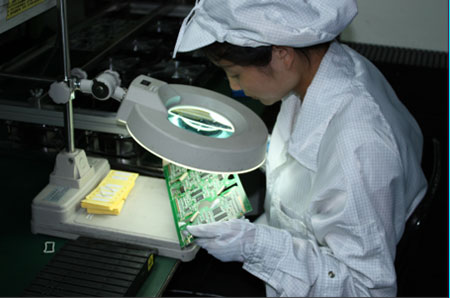About us
FASTPCBA Co.,Ltd
-
 Building 1, Senyang Electronic Technology Park, Guangming High-tech Park, Yutang Street, Guangming District, Shenzhen City.
Building 1, Senyang Electronic Technology Park, Guangming High-tech Park, Yutang Street, Guangming District, Shenzhen City.
-
 F:86-13418481618
F:86-13418481618
-
 [email protected]
[email protected]
 date:2019-09-25 10:11:52
date:2019-09-25 10:11:52
PCB assembly pad over wave soldering defect analysis and solution
Why is there a defect in the wave soldering of the PCB assembly pad? The following PCB manufacturers give you an analysis of the causes and solutions.

1. PCB assembly circuit board design is unreasonable, the pad pitch is too narrow.
2. The plug-in components are irregular or the package is skewed, and the pins are close to or have been touched before soldering.
3. PCB assembly circuit board preheating temperature is too low, components and PCB heat absorption during soldering, so that the actual soldering temperature is reduced.
4. The soldering temperature is too low or the belt speed is too fast, so that the viscosity of the molten solder is lowered.
5. Flux activity is poor.
Therefore, PCB manufacturers' solutions are:
The first is designed according to the PCB design specifications.
The second plug-in component pins should be formed according to the PCB hold distance and assembly requirements.
Third, according to the PCB size, the number of layers, the presence or absence of mounting components, etc., the preheating temperature is set, and the bottom temperature of the PCB is between 90 and 130 °C.
The fourth tin wave temperature is (250 ± 5) ° C, and the welding time is 3 to 5 s. When the temperature is slightly lower, the conveyor speed should be slower.
The fifth replacement flux.
Common PCB assembly pads have the following defects when over wave soldering
(1) The board surface is dirty. This is mainly due to the high solid content of the flux during the PCB assembly process, the excessive coating amount, the preheating temperature is too high or too low, or the transfer of the mechanical claws is too dirty, causing excessive oxide and the tin slag in the pot
(2) PCB deformation. Generally occurs on large-size PCB boards, due to the large weight of large-size PCB boards or the uneven quality due to uneven component placement. This requires the components evenly distributed during pcb layout, and design the process side in the middle of the large-size PCB.
(3) Drop (lost). The quality of the adhesive glue is poor, or the curing temperature of the adhesive glue is not correct. If the curing temperature is too high or too low, the bonding strength will be lowered. When the wave soldering is not able to withstand the effects of high temperature impact and peak shear force, the mounted components will fall in the pot.
(4) Other hidden defects. X-ray, solder joint fatigue test, etc. are required for solder joint grain size, internal stress of solder joint, internal crack of solder joint, brittle solder joint, and poor solder joint strength. These defects are mainly related to soldering materials, adhesion of PCB assembly pads, solderability of solder joints or leads of components, and temperature curves.
 Building 1, Senyang Electronic Technology Park, Guangming High-tech Park, Yutang Street, Guangming District, Shenzhen City.
Building 1, Senyang Electronic Technology Park, Guangming High-tech Park, Yutang Street, Guangming District, Shenzhen City.
 F:86-13418481618
F:86-13418481618
 [email protected]
[email protected]